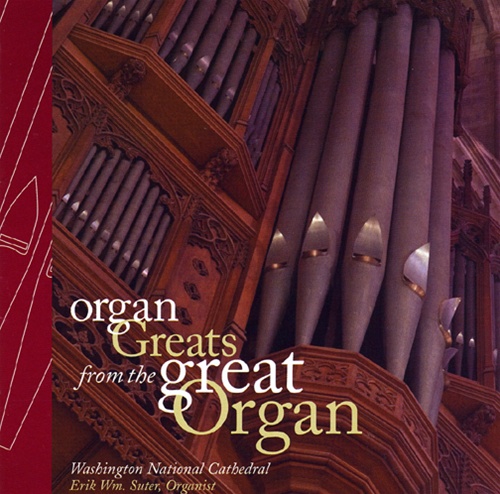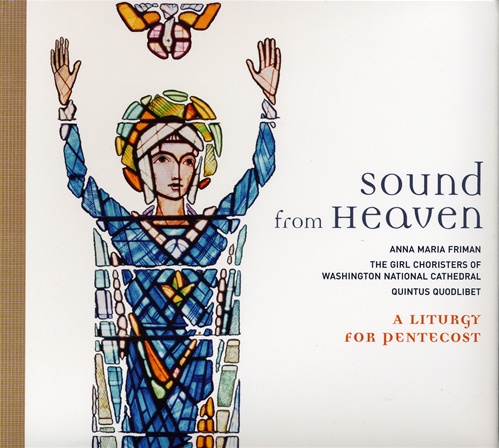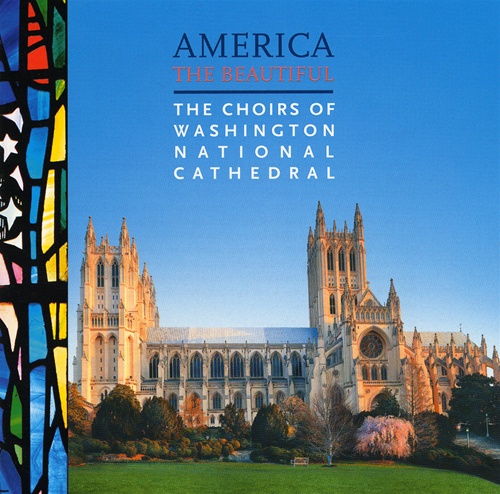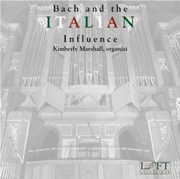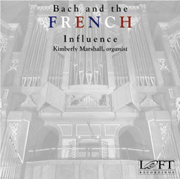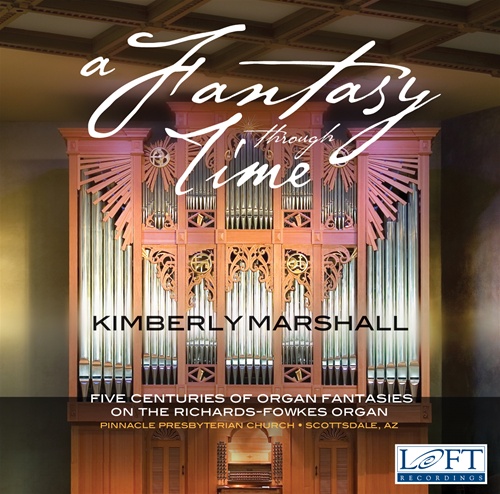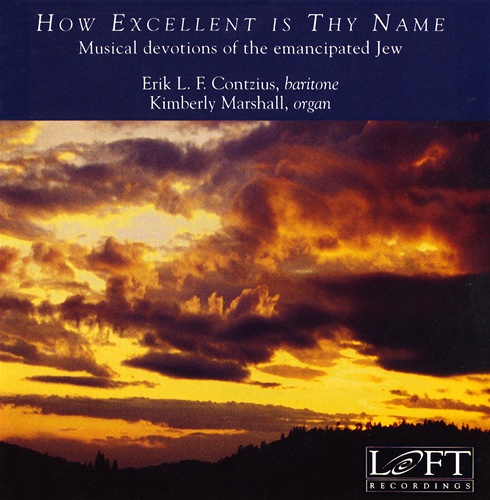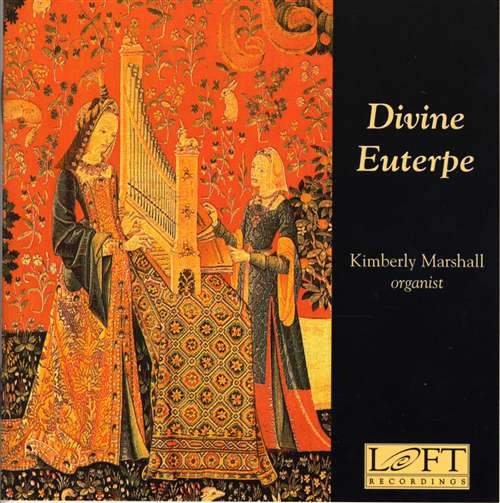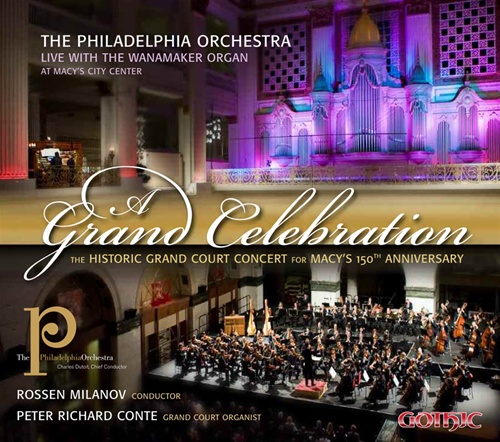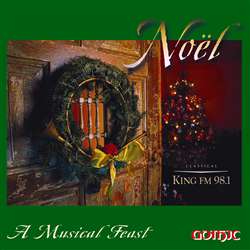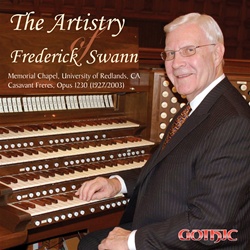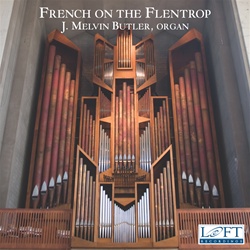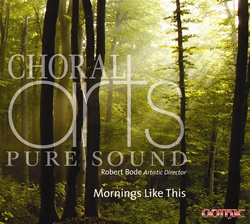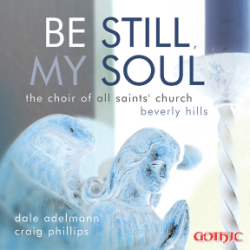We're celebrating our artist
Kimberly Marshall this week, so we wanted to prove to you how amazing these specials are by highlighting the albums that Kimberly Marshall has recorded with Loft Recordings that are ON SALE NOW!
How Excellent is Thy Name
Musical Devotions of the Emancipated Jew
Murray Harris organ, Stanford Memorial Church
Kimberly Marshall, organ
Hazzan Erik L.F. Contzius, cantor
List Price: $18.98
Our Price: $9.98
You save $9.00!
Buy Now to Save!
"This recording honors the Jewish liturgical tradition of cantor with organ-- and a rising star of American cantors. The historic 1901 Murray Harris organ at Stanford University is the perfect instrument for this music, which is concentrated in the latter half of the 19th and early 20th centuries."
V'sham'ru/ Biblical Cantilation
V'sham'ru/ Louis Lewandowski
Hashkiveinu/ Eduard Brinbaum
Adonai Malakh/ Hugo Chaim Adler
Lekha Dodi/ Lazar Weiner
Psalm 8/ Isadore Freed
May the Words/ Lazar Weiner
Kiddush/ Joseph Myerov
Sh'ma Koleinu/ Max Helfman
Avinu Malkeinu/ Max Janowski
Modim/ Jocob Rappaport
Cause Us, O Lord Our God/ Martin Kalmanoff
We Gratefully Acknowledge/ Abraham Levitt
Ahavat Olam/ Morris Barash
Dienen/ Ofer Ben-Amots
Hashkivenu/ Herman Berlinski
Psalm 23/ Bonia Shur
Yism'khu/ Hassidic, arr. Bonia Shur
Shalom Rav/ Erik L. F. Contzius, arr. B. Shur Uv'yom
Hashabbat/ Ofer Ben-Amots
Psalm 133/ Salomon Sulzer
Details
At no other time in Jewish history has there been such a surge of musical creativity in synagogue music as after the European emancipation in the 1700s. Modern Jewish composers with traditional sensibilities and contemporary training enriched worship greatly. These composers respected the norms of Jewish musical structure, originating from the earliest of ancient Biblical chants (V’sham’ru, track 1), and also preserved the modalities (nusakh) of that music. Yet, emancipation exposed these composers to the greater musical culture, influencing their compositional styles.
Until the nineteenth century, the prevalent modality of Jewish worship through musical expression was through the cantor or hazzan—the prayer leader who would improvise elaborate musical lines within the context of the musical guidelines passed aurally from generation to generation. His voice (and it was only a male until this century) was unaccompanied by instrument or choir. Hence it was through florid melismatic singing that he could establish a sense of key. When the liberated Jewish composers of the nineteenth century were charged by their congregations to make the service more accessible to the Western ears of their congregants, they closely examined the role of the cantor and the expression and function of his music.
When reform was taking hold in the synagogues of Europe, Jewish congregations embraced the dominant culture’s mode of prayer—that of the Protestant Church: instruments and choirs were introduced. Hymns, a musical form foreign to the synagogue, were sung by the congregation, and the vernacular language was used in place of the traditional Hebrew. In light of this, composers like Louis Lewandowski and Eduard Birnbaum (tracks 3 & 4) tried to preserve the flavor and language of the improvised cantorial stylings of yesteryear, while injecting a Western sense of harmony and melodic structure. No other composer had as much success at this within the synagogue as Cantor Salomon Sulzer (track 21).
A sense of how the improvised style was portrayed can be heard in the works of Jacob Rappaport and Morris Barash (tracks 11 and 14). Their organ accompaniments echo the first use of the choir in the synagogue—the chor shul (lit. “choir synagogue”). Male choirs would accompany the cantor, reinforcing the harmony established by his melismatic chanting. These two offerings of cantorial art music are presented here to illustrate the difference between the old and new stylings of Jewish composition for the synagogue.
Innovation and radical change really took hold both in the synagogue and in synagogue music when liberal Jewry began to flourish in the United States of America. Trying to establish an American Jewish musical culture separate and distinct from Europe was the goal of many of America’s finest musical liturgists. This yielded a body of music used widely, even today, in a period described as Classical Reform.
Cantor Hugo Chaim Adler (track 4) was a cantor with the ability to preserve traditional nusakh and flavor of traditional worship while giving great form to the melody and harmonization of his compositions. His Adonai Malakh stands out as a piece which, without the accompaniment, could easily be used in traditional worship today.
Lazar Weiner (Lekha Dodi, track 5 and May the Words, track 7) was, according to Jewish composer Herbert Fromm, “the undisputed master of the secular Yiddish art song.” He truly paints the meaning of the text, complementing the flowing melodic line with a delicate accompaniment. This can be heard in his Lekha Dodi, as it welcomes in the Sabbath not with a shout, but with a loving voice. Weiner’s meditative music preceding the text of his May the Words also makes great use of the subtleties of the organ.
A signature piece of Isadore Freed (track 6), his Psalm 8 takes advantage of the pipe organ as accompanying instrument. This piece does not show Freed’s adherence to the traditional modes of Jewish music, since this English text is not married to a specific liturgical use. Freed was a great advocate not only of the proper use of nusakh, but also wrote a book entitled Harmonizing the Jewish Modes, which describes the details of writing accompaniments for the differing modal characteristics in the Ashkenazi (European) Jewish tradition.
Joseph Myerov (track 8), an organist and music director, brings a quiet beauty to the Kiddush, the blessing over the Sabbath wine. The composer reflects the text with a melodic line that “flows like wine.” This melodic flow, with its polytonal accompaniment, captures the majesty of chanting the blessing over wine and rejoicing in the Sabbath.
There are two composers from the twentieth century who lent their musical characteristics to the hallmark of classical Reform musical literature: Max Helfman (Sh’ma Koleinu, track 9) and Max Janowski (Avinu Malkeinu, track 10). Both of their seminal works are presented here: Helfman’s Sh’ma Koleinu is a stirring setting, pleading that God should hear our voice. He recaptures the melismatic and dramatic character of traditional cantorial art music, while providing an accompaniment that supports and enhances the meaning of the text. Max Janowski’s Avinu Malkeinu bears a melody which has its root in traditional origins. Its drama and grandeur have made it an enduring feature of the Jewish High Holy Days.
The character of music composed for the modern synagogue has undergone gradual but distinct changes. Some composers have chosen to embrace the musical styles of their surroundings, while others have reached back to more traditional arrangements.
Both Martin Kalmanoff (track 12) and Cantor Abraham Levitt (track 13) exhibit distinct musical influences from the worlds of jazz and popular music. Their harmonies are familiar to the modern Jew. They have also embraced the vernacular in the texts of their compositions.
Possibly the most radical fusion of music of the modern era and cantorial stylings can be seen in the music of Herman Berlinski (track 16). A music director and organist, he has elevated an already stirring text to a level of fine art, fusing the prayer space between both singer and organ into a seamless whole. The setting cannot exist without either voice or organ, and the dialogue between the two shines when just one of the pair is featured.
Israeli born Ofer Ben-Amots (tracks 15 and 20) takes a more romantic approach in his settings. His music feels more ancient even than the cantorial art music he imitates. The settings of his works presented here were originally scored for chamber orchestra and voice, but Ms. Marshall’s accompaniment illustrates the ease with which the textures of this music can be adapted to the organ.
Born in Riga, Latvia, Bonia Shur (track 17 and 18) has brought many modern characteristics to Jewish music. Rejecting the notion of preserving the traditional musical modalities, Shur has brought different elements into Jewish worship with his Israeli folk stylings and modal melodic lines (for example, the use of a lowered sub-tonic in place of leading tone can be heard in many of his compositions). Shur has been on the faculty of the Cincinnati campus of Hebrew Union College-Jewish Institute of Religion for many years as Director of Liturgical Arts, teaching Reform Rabbis about all aspects of Jewish music.
I have included in this collection a collaboration between myself and Bonia Shur: Shalom Rav (track 19). I wrote the melody two days after Yitzhak Rabin was assassinated, having been asked to participate in a memorial service in his memory. I felt that the setting of this song of peace needed to be hopeful, like Rabin’s vision of peace in Israel, but subdued and perhaps even desparate. Bonia Shur’s accompaniment and harmonic suggestions completed my composition.
In this day of Israel’s political situation and climate, I think of Shalom Rav now more of a prayer which seeks to further Rabin’s dream of a united Jerusalem, and a day when all peoples may one day live in Israel in wholeness and peace.
- Hazzan Erik L. F. Contzius
The organ is a relative newcomer to Jewish liturgical music, and its participation is generally limited to accompanying services in the Reform tradition.
Despite the intricate and opulent use of instrumental music in the liturgies of the First and Second Temple (as documented in Chronicles I and II and the Talmud), following the Second Temple’s destruction in 70 C.E. no attempt was made to reinstate this musical practice. On the contrary, instrumental music was banned from the Jewish liturgy to symbolize mourning over the Temple. This is reflected in passages from the Talmud: “from the day the Temple was destroyed, there has been no day without a curse” and “when the rabbinical court [Sanhedrin] ceased to exist, song ceased from the places of feasting.” (M. Sotah IX, 12, 11) Indeed, an extremist view states that no one should even smile until the Temple and its sacrificial rite are restored. But this exclusion of instruments from the synagogue did not reflect a negative attitude towards them by the Jewish authorities; rather, instrumental music was an essential part of the sacrificial rite and as such held no place in the newly evolving synagogue liturgies that developed after the Temple’s destruction.
The organ was adopted to accompany singing during synagogue worship as part of the reformed liturgical practices introduced in Germany in the nineteenth century. The choice of the organ was clearly taken from the mainstream culture of Christianity, as were other aspects of the early Reform movement: Shabbat was observed on Sundays and much of the Hebrew service was translated into the vernacular.Perhaps more significantly, synagogues were considered to be modern Temples in their own rights, without the emphasis on restoring a lost sacrificial rite.It was in this frame of mind that man Jewish congregations n Germany and eastern Europe installed impressive organs in their Temples, leading to a flowering of musical composition for cantor, choirs, and organ.
During the twentieth century, there has been a backlash against the more assimilationist facets of the early Reform movement, and this has led to ambiguous views of the organ and its role within modern Jewish liturgical practice. The very sound of the organ reeks of the Church to those who are not knowledgeable of the fine tradition of Jewish music written expressly for the instrument. As a sort of compromise between this fundamental “distrust” of the organ and the need for an instrument to support singing, some Temples have opted to buy pianos (at a fraction of the cost of an organ), while others have resorted to synthesizers and electronic imitations that at best fall very short of the finesse and subtlety available on the organ. Only the largest and wealthiest congregations have maintained the liturgical use of the instrument at the high standard with which it was first introduced to Judaism. Yet despite the rather sad current state of the organ within the Reform movement, a wealth of superb music has continually been composed for cantor and organ, as reflected in the repertoire heard here.
This recording reflects my desire to honor the long tradition of Jewish liturgical music for the organ with a two-fold purpose: to educate those who would spurn the instrument on grounds of assimilation, and to make known to a wider listening public the many gems of musical expression that have been inspired by the Jewish liturgy. The organ has the greatest variety of sounds and pitches of any single musical instrument, and it is ideally suited to leading a congregation in worship, whether it be in majestic praise of God or in quiet contemplation of the divine.
The vast palette of timbres necessary to convey the many styles of music that Erik and I have included here is amply furnished by the Murray Harris organ at Stanford University. Constructed in 1901, this specimen of one of America’s greatest organ builders has survived two major earthquakes (as well as the often more damaging vicissitudes of changing aesthetics!) to remind us today that a beautiful instrument never becomes obsolete, only misunderstood or neglected. It is my hope that this recording will foster interest in the fine repertoire of Jewish liturgical music for the organ so that it will be understood and cherished.
- Dr. Kimberly Marshall
Music by Women: Divine Euterpe
Rosales Organ, Trinity Cathedral, Portland, OR
Kimberly Marshall, organ
List Price: $18.98
Our Price: $9.98
You save $9.00!
Buy Now to Save!
This recording traces the works of female composers from Medieval times through the twentieth century. Played on the Rosales organ of Trinity Episcopal Cathedral in Portland, Oregon, this program includes some music never before recorded on compact disc. Featured composers include Elfrida Andree, Florence Price, Ethel Smyth, and Fanny Mendelssohn.
Agincourt Carole/ Anonymous
Susanna van Soldt notebook 1599 (Excerpts/ Anonymous
Verses on the Veni Creator/Anonymous
Organ Symphony in b-minor/ Elfrida Andrée (1841-1929)
Suite for Organ No. 1/ Florence Price (1888-1953)
Prelude and Fugue on O Traurigkeit, O Herzeleid/ Ethel Smyth (1858-1944)
Mass L'homme armé/ Margaret Vardell Sandresky (b. 1921)
Prelude for Organ/ Fanny Mendelssohn (1805-1847)


